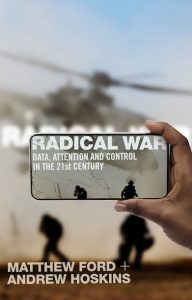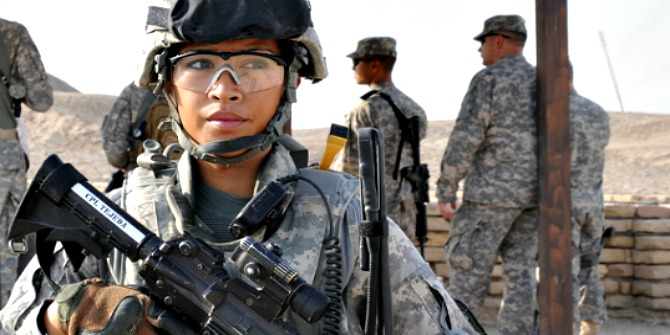In Radical War: Data, Attention and Control in the Twenty-First Century, Matthew Ford and Andrew Hoskins explore how digital technologies, datafication and related media practices have transformed war today. This timely book invites readers to reconsider the changing relationship between media and conflict that has given rise to ‘radical war’, writes Scott Timcke.
Radical War: Data, Attention and Control in the Twenty-First Century. Matthew Ford and Andrew Hoskins. Hurst Publishers. 2022.
Find this book (affiliate link):![]()
 Amidst recent changes in networked consumer technologies and media practices, Matthew Ford and Andrew Hoskins ask how these developments alter warfare. Leveraging the claim that ‘there can be no political violence without its digital representation’ (15), the central concern of Radical War is with the refiguring of how citizens, security policymakers, technologists, users and audiences pay attention to and comprehend war. By moving beyond state-centric — and even combat-centric — interpretations (10), Ford and Hoskins ask readers to reconsider the relationship between war and media in light of the production of global computational infrastructure in the 21st century. They call this broad development ‘radical war’.
Amidst recent changes in networked consumer technologies and media practices, Matthew Ford and Andrew Hoskins ask how these developments alter warfare. Leveraging the claim that ‘there can be no political violence without its digital representation’ (15), the central concern of Radical War is with the refiguring of how citizens, security policymakers, technologists, users and audiences pay attention to and comprehend war. By moving beyond state-centric — and even combat-centric — interpretations (10), Ford and Hoskins ask readers to reconsider the relationship between war and media in light of the production of global computational infrastructure in the 21st century. They call this broad development ‘radical war’.
In their examination of ‘the new ecology of war’ (xix), Ford and Hoskins propose that the above accumulated effects ‘decentre[s] the battlefield’ (20). On the whole, Ford and Hoskins argue that most participants understand that digital connectivity is an aspect of conflict, but few grasp the ramifications of this connection. In a disquieting addition to the past two decades of forever wars, ‘now war is everywhere’ (7), Ford and Hoskins write.
When thinking about war, Ford and Hoskins wish to avoid giving undue credence to the hype cycles created by Silicon Valley about the impact of artificial intelligence (AI) and machine learning. They also seek to skirt the profitable alarmism about cybersecurity disseminated by think tanks. In broad strokes, the ecology they describe is fairly mundane. It relies less upon fantastical technologies and more upon ‘the habituated use of the smartphone’ (163). Through datafication, these devices help populate vast archives from which kill chains, for example, can be assembled. The effect of these social and technical changes is ‘both a clarification and a distortion of our appreciation of war’ (23).

Image Credit: Image by Markus Winkler from Pixabay
Ford and Hoskins draw attention to ‘a connective turn’ which, rightly in my view, affects the ‘entire epistemological framework for understanding the world’ (75). These changes to meaning-making are in sharpest relief when comparing media and warfare in modernity.
First detectable in newspaper coverage of the Crimean War (1853-56), for about 150 years there has been a consistent ‘Western mode of perceiving war’ (60). Stabilised by television and mass audiences more recently, this mode understands the causes and action of war as remote, as separate and distinct from everyday life.
Yet these assumptions do not match the present media ecology where elements of war are within arm’s reach in metropoles. Western states no longer simply fight ‘over there’. Corporate technologists play a decisive role in this new ecology of war, if only because they develop and control the key infrastructure and platforms upon which data, attention and control of images of war circulate. But states are also struggling to maintain control over those same firms too.
In Ford and Hopkins’ thought, smartphones, platforms and the wider ecology of networks mean that audiences will always be fragmented. Grand narratives are absolutely relics of the past, they imply. There are no central struggles that define history. What remains is micro-politics around particular issues, which at its zenith is wholly individual, idiosyncratic and incommutable. It may well be an opportunity for radical self-framing too, but datafication reinforces estrangement as ‘digital churn’ repeatedly collapses context. We may be neighbours, but what you and I see on Twitter is so vastly different, we might as well be oceans apart.
As images and information do not come to audiences in chronological order, the plurality of data has narrative implications for the causes and assessment of acts of conflict. Reddit’s r/CombatFootage is a good example of videos of war posted to gain attention. In radical war, state conquest is an afterthought, maybe even combat operations too: ‘Now war is principally about managing the attention of populations and different audiences’ (11). Given this ‘media spectacle’ (33), Ford and Hoskins urge readers to ‘rewrite how we come to know and understand war’ (10), because ‘it is not possible to locate these emergent forms of warfare within existing models of representation and ways of seeing the world’ (70).
Some of these changes were detectable in the US occupation of Iraq as smartphones entered the battlefield from 2008 onwards. Archives are an important component in the ecology Ford and Hoskins identify, for the data they contain can become used for target identification. There are real prospects that automated network analysis could link discrete datasets to generate patterns. When these conditions are met, ‘the result is an infinite capacity to produce targets’ (9). With smartphones generating so much data, these devices can also conceivably become part of a kill chain. There is considerable merit to this argument, although I think the authors rhetorically overplay it when writing that the smartphone is ‘replacing the rifle as the weapon of choice for those engaged in mass participation in war’ (10).
Sensing that there is a gap between the conditions for warfighting and combat doctrines, Western military bureaucracies have shifted, albeit reluctantly, regarding some elements in the command structure. For instance, the US military sought to become sensitive to local concerns by encouraging combat brigades to cultivate an ethnographic imagination to assist with counter-insurgency operations in Iraq and Afghanistan. Still, Ford and Hoskins insist, the new digital ecology means that narratives and counter-narratives about war are too fractured for institutions to even have a modicum of control. There is a risk of war becoming de-institutionalised, where even the institutions purpose-built to focus on war are rendered useless.
As an example of this fracture, Ford and Hoskins point to memories. In a very astute observation, Ford and Hoskins explain how ‘our shared understanding of the past’ is bound by a ‘sedimented appreciation for war in history as framed by analogue archives versus the digital churn of a present framed by social media’ (117-18). Digital churn can concurrently use disembedded images from the past to support present grievances, while also enrolling these images into the ‘perpetual present’ that Fredric Jameson wrote about in Postmodernism, or, The Cultural Logic of Late Capitalism.
Detailing the changing relationship between how wars are fought and how they are comprehended is a big ask of any field of research, let alone the work of two established scholars. Those looking to take them to task for hubris ought to pause, for Ford and Hoskins admit that they do not wish to present ‘a complete theory of war in the twenty-first century’ (10). Yes, the book is written in a declaratory tone. But the text is more suggestive than it first appears. The point the authors most insist upon is that the circulation of media disrupts axioms that held fast for the bulk of the twentieth century.
Still, Radical War was written before the 2022 Russian invasion of Ukraine, but much of what is happening in that war validates Ford and Hoskins’ writing. Social media audiences can readily find helmet-mounted camera footage of combat operations and follow celebrity soldiers posting selfies. Smartphone photos allow hobbyists to tally equipment losses while also revealing Russian war crimes in Mariupol. So this line of inquiry is very promising. But it does prompt several questions, some of which are worth raising here.
To begin, what is the chance that Ford and Hoskins’ framing of social technical changes could bring about a ‘war without bystanders’ (47)? I cannot help shake the feeling that this kind of language helps ‘[collapse] the boundary between those who observe war and those who engage in it’ (47). Surely the reluctant ‘participant combatants’ (47) deserve finer distinctions?
And second, war involves coercion and construction. The latter involves efforts to make peace, which is already complicated enough. If one consequence of the collapse of a common frame of reference is that participants can have vastly different conceptions of the causes of war, how does ‘radical war’ end when participants do not have a broad consensus for armistice? Relatedly, if war is partly de-institutionalised, how does this new ecology of war reshape the prospects for peace-making, for finding ways in which war is nowhere? Ford and Hoskins do not say. To me, this is where future research could begin.
- This review first appeared at LSE Review of Books.
Please read our comments policy before commenting.
Note: This article gives the views of the author, and not the position of USAPP – American Politics and Policy, nor of the London School of Economics.
Shortened URL for this post: https://bit.ly/3z0e971
About the reviewer
Scott Timcke – University of Johannesburg
Scott Timcke is the author of Capital, State, Empire: The New American Way of Digital Warfare and Algorithms and The End of Politics: The Shaping of Technology in 21st Century American Life. He is a Research Associate with the University of Johannesburg’s Centre for Social Change and an affiliate with the Center for Information, Technology, and Public Life, University of North Carolina at Chapel Hill. He has held fellowships with the Centre for African Studies, University of Leeds and the Center for Advanced Internet Studies.






